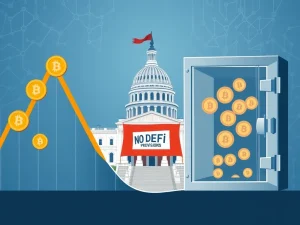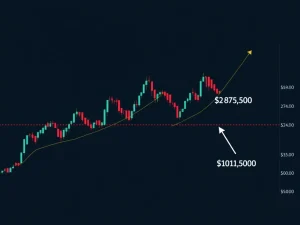Tether’s Triumphant Return: USDT Supply Surges 18% to $162B as GENIUS Act Opens U.S. Market

In a significant turn of events, Tether, the undisputed titan of the stablecoin world, is making a strategic reentry into the U.S. market. This bold move comes after years of navigating a complex regulatory landscape and marks a pivotal moment for the company and the broader digital asset space. What’s behind this dramatic shift? A new piece of legislation, the GENIUS Act, signed into law by President Donald Trump, has seemingly paved the way for Tether to once again focus on the U.S. institutional market.
Tether’s Strategic U.S. Reentry: What’s Driving the Change?
For years, Tether has operated largely from offshore jurisdictions, facing intense scrutiny from U.S. regulators. Its 2021 retreat from the U.S. market, which included a $60 million settlement and a ban from New York, stemmed from allegations of misleading claims about its reserve assets. Fast forward to mid-2025, and the narrative has completely flipped.
CEO Paolo Ardoino confirmed in a Bloomberg interview that Tether is reigniting its U.S. ambitions. This renewed focus is squarely aimed at the institutional market, with plans to expand the use of its U.S. Dollar-backed token, USDT, for payments, interbank settlements, and trading. This signals a mature approach, prioritizing compliance and institutional partnerships, a stark contrast to its earlier, more aggressive market penetration strategies.
The GENIUS Act: A Game-Changer for Stablecoin Regulation?
The catalyst for Tether’s U.S. comeback is the recent enactment of the GENIUS Act on July 17, 2025. This landmark stablecoin legislation aims to streamline regulatory frameworks for stablecoin issuers, potentially opening doors for traditional financial entities like banks, payment networks, and tech firms to create their own digital tokens.
The act’s passage creates a more favorable and, crucially, clearer operating environment for companies like Tether. For an industry often criticized for its regulatory ambiguity, a dedicated piece of legislation offers a much-needed roadmap. It suggests a growing recognition from policymakers of stablecoins’ potential to disrupt traditional financial infrastructure, while also attempting to mitigate systemic risks.
USDT’s Remarkable Growth and Market Dominance
Despite past regulatory hurdles and its offshore operational base, Tether’s USDT has not only retained its dominance but has also seen impressive growth. As of mid-2025, its circulating supply stands at a staggering $162 billion, marking an 18% increase since January of the same year. To put this into perspective, its closest competitor, Circle’s USDC, trails significantly with $64.7 billion in circulation.
This sustained growth underscores USDT’s critical role in the global crypto ecosystem, serving as a primary liquidity bridge between fiat and cryptocurrencies, especially in emerging markets where it maintains a competitive edge. The sheer volume of USDT in circulation highlights its deep integration into trading pairs, decentralized finance (DeFi), and cross-border remittances.
| Stablecoin | Circulating Supply (Mid-2025) | Growth Since Jan 2025 |
|---|---|---|
| Tether (USDT) | $162 Billion | 18% |
| Circle (USDC) | $64.7 Billion | – |
Navigating the U.S. Market: Compliance and Caution
While the GENIUS Act offers a welcoming hand, Tether remains cautious about its public market exposure. Unlike Circle Internet Financial, which saw its stock surge over 500% since its June IPO, Tether has no immediate plans to go public. “In general, we are not interested in becoming a public company,” Ardoino stated, signaling a preference for private operations and perhaps less direct public scrutiny.
The company’s past challenges, particularly the lack of third-party audits for its reserves, continue to be a significant point of contention. Ardoino acknowledged ongoing discussions with auditing firms but provided no specific timeline for completion. This transparency gap remains a major hurdle for broader institutional adoption and regulatory acceptance, especially as U.S. regulators, including the Federal Reserve and SEC, have intensified oversight of stablecoins following the 2022 collapse of TerraUSD.
Tether’s strategy hinges on leveraging its technological expertise and decade-long market experience to navigate these complexities. The company understands that its success in the U.S. market will depend heavily on demonstrating unwavering transparency and aligning with evolving regulatory expectations.
What’s Next for Stablecoins and Regulatory Oversight?
The stablecoin market, now valued at over $252 billion, is a hotbed of innovation and regulatory attention. Its potential to disrupt traditional finance is immense, but so are the inherent risks. Reports like CertiK’s, highlighting $2.47 billion in losses tied to stablecoin vulnerabilities, underscore the critical need for robust safeguards and comprehensive regulatory frameworks.
Tether’s reentry coincides with broader macroeconomic uncertainties, including shifting trade policies and market volatility. While these factors could complicate market entry, Tether’s renewed emphasis on regulatory compliance could help mitigate potential risks. The company’s past legal battles serve as a stark reminder of the delicate balance between fostering innovation and ensuring stringent oversight in the digital asset sector.
Ultimately, the GENIUS Act may provide a clearer path for stablecoins to integrate into mainstream finance. However, widespread adoption and trust will require continued efforts from issuers like Tether to address lingering skepticism from regulators and institutional investors alike, ensuring that transparency and security are at the forefront of their operations.
Frequently Asked Questions (FAQs)
What is the GENIUS Act and how does it impact Tether?
The GENIUS Act is a landmark stablecoin legislation signed into law by President Donald Trump on July 17, 2025. It aims to streamline regulatory frameworks for stablecoin issuers, creating a more favorable and clearer environment for companies like Tether to operate in the U.S. market.
Why did Tether reenter the U.S. market after its previous retreat?
Tether’s reentry is primarily driven by the enactment of the GENIUS Act, which provides a more defined regulatory framework. CEO Paolo Ardoino confirmed this strategic pivot, signaling the company’s intent to focus on the U.S. institutional market with a renewed emphasis on compliance and partnerships.
How much has USDT’s supply surged, and how does it compare to USDC?
As of mid-2025, Tether’s USDT circulating supply surged by 18% since January, reaching $162 billion. Its closest competitor, Circle’s USDC, trails with $64.7 billion in circulation, maintaining USDT’s dominant position in the stablecoin market.
Is Tether planning an IPO like Circle?
No, Tether has stated it has no plans to become a public company. CEO Paolo Ardoino explicitly mentioned that the company is “not interested in becoming a public company,” contrasting with Circle Internet Financial, which has seen its stock surge since its IPO.
What are the main challenges Tether still faces regarding regulation and transparency?
Tether continues to face criticism over the lack of independent third-party audits for its reserves, a transparency gap that remains unaddressed despite ongoing discussions with auditing firms. Additionally, U.S. regulators, including the Federal Reserve and SEC, have intensified oversight of stablecoins following past market events, demanding greater transparency and collateral management.









